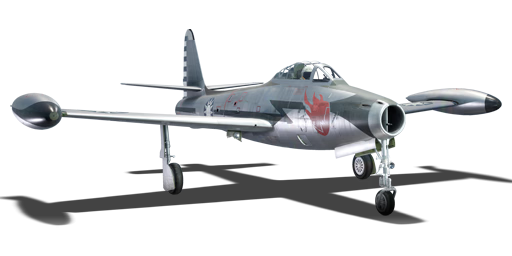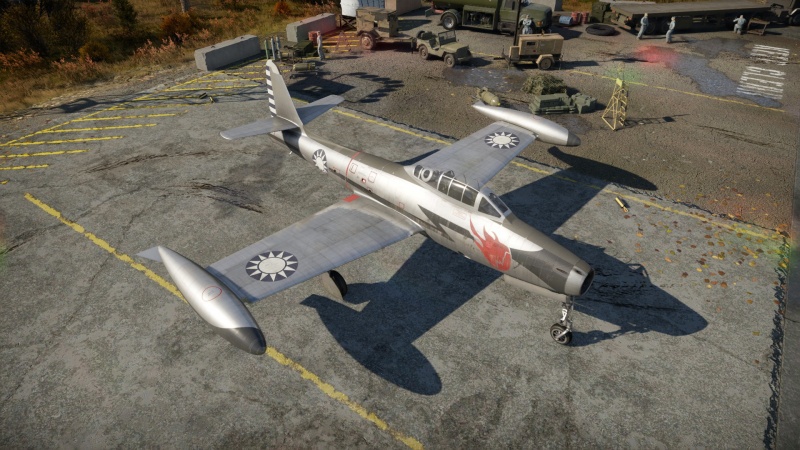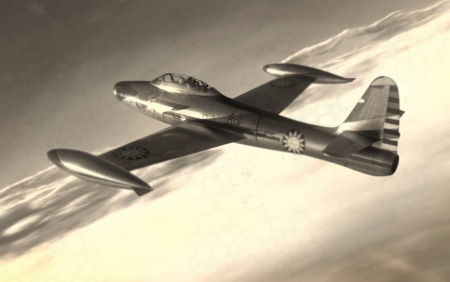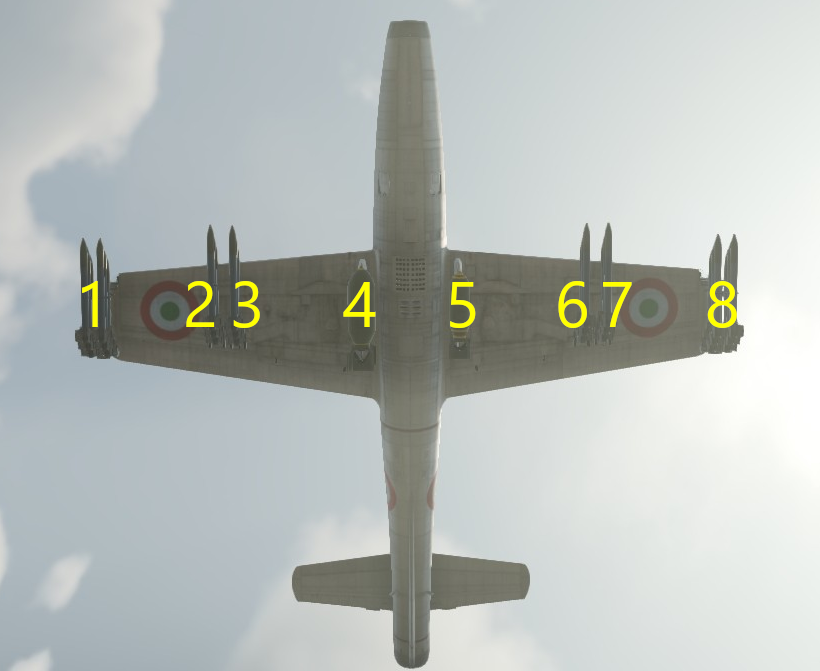F-84G-21-RE (China)
| This page is about the strike aircraft F-84G-21-RE (China). For other versions, see F-84 (Family). |
Contents
Description
The ␗F-84G-21-RE Thunderjet is a rank V Chinese strike aircraft with a battle rating of 7.7 (AB/RB) and 8.0 (SB). It was introduced in Update 1.91 "Night Vision".
The F-84 Thunderjet was among the first American jet aircraft sold to the Republic of China Air Force, and in War Thunder it will often be a starting jet for Chinese pilots entering Rank V. It has a lot of perks to offer while still being a smooth transition from propeller fighters. Like the ROCAF P-47D-28 Thunderbolt, another beloved fighter-bomber from the same manufacturer, the Thunderjet has a large yet sleek appearance, a high top speed, six .50 caliber Browning machine guns, and a huge payload of bombs and rockets. It has competitive performance for air combat while being more forgiving than the PLAAF's starting MiG-9, and can be very effective in Ground RB as well. Pilots who master the F-84G will earn a great plane for both air superiority and close air support, and be prepared for future Chinese jets.
General info
Flight performance
The F-84G is a streamlined all-metal jet fighter which was designed to house the upgraded Allison J35-A-29 turbine jet engine. Though an upgraded engine compared to the F-84B, typically this fighter was laden with more ordnance thus still requiring a significant roll-out time of 1,040 m (~3,400 ft) before lift-off. Don't be dismayed as other fighters are taking to the sky while you are still building up speed as once in the air you can climb to bomber altitude or set up for a ground attack run that few others can rival.
Though the take-off and climb characteristics of the Allison jet engine appeared lacklustre, it actually had decent level flight speed and good dive characteristics. Speed is what saves this fighter, in once it has enough built up, it will perform. Though not the fastest at its battle rating, the F-84G is a great boom & zoom aircraft vs. being a dogfighter. Turning this aircraft will bleed its speed and the roll rate can be affected by the weight of the wing-tip fuel tanks. One negative aspect of the wing-tip fuel tanks of the early F-84s was that high speeds (>1,000 km/h) tended to cause the fuel tanks to twist resulting (mitigated by the addition of fins on the tanks) in the destruction of the wings which does reflect in realistic and simulator battles in-game if exceeded. While turning in this jet is not advised, Immelmann and Split-S manoeuvres will help to conserve energy without compromising the speed of the aircraft.
If ever in danger of risking going faster than maximum rip speed, it is important to throttle back and extend air-brakes to reduce speed enough to keep the aircraft intact and manoeuvre in for the kill.
| Characteristics | Max Speed (km/h at 0 m - sea level) |
Max altitude (metres) |
Turn time (seconds) |
Rate of climb (metres/second) |
Take-off run (metres) | |||
|---|---|---|---|---|---|---|---|---|
| AB | RB | AB | RB | AB | RB | |||
| Stock | 976 | 971 | 12500 | 29.0 | 30.4 | 30.8 | 29.3 | 3,000 |
| Upgraded | 993 | 985 | 27.2 | 28.0 | 42.1 | 36.2 | ||
Details
| Features | |||||
|---|---|---|---|---|---|
| Combat flaps | Take-off flaps | Landing flaps | Air brakes | Arrestor gear | Drogue chute |
| ✓ | ✓ | ✓ | ✓ | X | X |
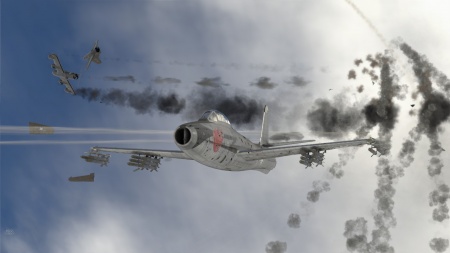
| Limits | ||||||
|---|---|---|---|---|---|---|
| Wings (km/h) | Gear (km/h) | Flaps (km/h) | Max Static G | |||
| Combat | Take-off | Landing | + | - | ||
| 1044.75 | 320 | 527 | 499 | 350 | ~11 | ~5 |
| Optimal velocities (km/h) | |||
|---|---|---|---|
| Ailerons | Rudder | Elevators | Radiator |
| < 530 | < 600 | < 690 | N/A |
Engine performance
| Engine | Aircraft mass | |||||
|---|---|---|---|---|---|---|
| Engine name | Number | Empty mass | Wing loading (full fuel) | |||
| Allison J35-A-29 | 1 | 5,450 kg | 276 kg/m2 | |||
| Engine characteristics | Mass with fuel (no weapons load) | Max Takeoff Weight | ||||
| Weight (each) | Type | 8m fuel | 20m fuel | 27m fuel | ||
| 1,050 kg | Axial-flow turbojet | 5,868 kg | 6,447 kg | 6,685 kg | 9,979 kg | |
| Maximum engine thrust @ 0 m (RB / SB) | Thrust to weight ratio @ 0 m (100%) | |||||
| Condition | 100% | WEP | 8m fuel | 20m fuel | 27m fuel | MTOW |
| Stationary | 2,300 kgf | N/A | 0.39 | 0.36 | 0.34 | 0.23 |
| Optimal | 2,300 kgf (0 km/h) |
N/A | 0.39 | 0.36 | 0.34 | 0.23 |
Survivability and armour
- 38 mm Bulletproof glass in cockpit front.
- 6.35 mm Steel plate in front of pilot.
- 12.7 mm Steel plate in pilot's headrest.
- 8 mm Steel plate behind the pilot.
Like many early jet fighters, the armour was placed around the pilot while not much thought was given to the other critical components of the aircraft mostly due to the weight imposed on the early and weak turbojet engines placed into service. From behind, the pilot is protected by an 8 mm steel plate behind the seat with a 12.7 mm steel plate as a headrest. In front of the pilot, a 38 mm bulletproof windscreen adds protection from head-on's or from defensive bomber weapons. Another 6.35 mm steel plate is placed in front of the pilot and instrument panel for further protection of bullets entering the open-ended air-intake.
Other critical components such as the jet turbine, fuel tanks and coolers are all exposed, only protected by the outer skin of the aircraft which may deflect incoming bullets if at sufficient distance or angle to do so.
When attacking an F-84G, aim for the centre of the aircraft where you have a good chance of getting a critical hit on the engine or in a fuel tank. Due to this aircraft having wing-tip fuel tanks, shots to the wings or wing-tip tanks have a potential of starting a fire or breaking a wing off. If the attacking aircraft has sufficient calibre ammunition then shots taken at the pilot may have a larger chance of success if made from the sides or behind. This aircraft does not have much protection against rockets or missiles, however, given sufficient notice, rockets can be avoided and it is possible that missiles can be outmanoeuvred, however, when playing in realistic or simulator you run the risk of the pilot blacking-out due to G-force manoeuvres or wings snapping while trying to outfly a missile.
Modifications and economy
Armaments
Offensive armament
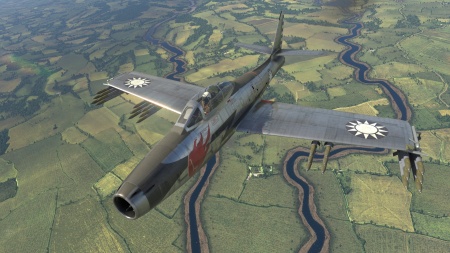
The F-84G-21-RE (China) is armed with:
- 4 x 12.7 mm M3 Browning machine gun, nose-mounted (300 rpg = 1,200 total)
- 2 x 12.7 mm M3 Browning machine gun, wing-mounted (300 rpg = 600 total)
The F-84G has four 12.7 mm M3 Browning machine guns mounted in the forward fuselage and two others mounted close by in the wing roots. Compared to the cannon armament of other contemporary jets, the Brownings have less stopping power and have trouble dismantling enemy aircraft. But they are accurate, easy to aim, and can still cause fires easily. The ammunition supply is also quite generous, although the enhanced rate of fire of the M3 Browning compared to the earlier M2 will eat through it quickly in full-auto.
Suspended armament
The F-84G-21-RE (China) can be outfitted with the following ordnance:
| 1 | 2 | 3 | 4 | 5 | 6 | 7 | 8 | ||
|---|---|---|---|---|---|---|---|---|---|
| 100 lb AN-M30A1 bombs | 1 | 1 | |||||||
| 250 lb AN-M57 bombs | 1 | 1 | |||||||
| 500 lb AN-M64A1 bombs | 1 | 1 | |||||||
| 1,000 lb AN-M65A1 bombs | 1 | 1 | |||||||
| HVAR rockets | 6* | 3 | 3 | 4 | 4 | 3 | 3 | 6* | |
| Tiny Tim rockets | 1 | 1 | |||||||
| Maximum permissible weight imbalance: 900 kg | |||||||||
| * HVAR rockets on hardpoints 1/8 may only be equipped simultaneously | |||||||||
| Default weapon presets | |
|---|---|
| |
The F-84G offers a range of bombs and rockets for destroying surface targets. Unguided bombs are mounted only on two fuselage hardpoints and the best choices are clearly the heavy 1,000 lb bombs. They drop individually and do not require a huge amount of precision to obliterate a capture point. Unfortunately, the need to fly directly above the target renders the Thunderjet vulnerable to SPAA fire in Ground RB, and radar guided systems like the M163 and ZSU-23-4 can easily shred unaware pilots.
Pilots who want something more adventurous can mount enormous Tiny Tim rockets on these pylons instead; the F-84G is the only aircraft in the Chinese tech tree with access to them. They have less explosive content than the 1,000 lb bombs but still enough to knock out tanks even on near misses, and can be launched from safer distances. The main drawback is that they take a lot of practice to aim effectively, especially because they drop from the pylon before the rocket motor ignites.
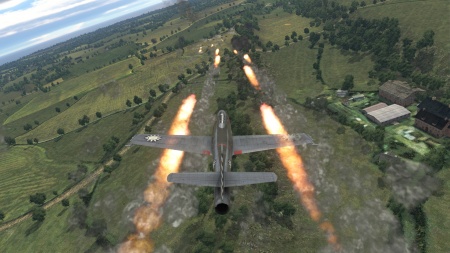
The remaining pylons are reserved for HVAR rockets. Previous P-47D pilots may have overlooked them because they are difficult to aim and have less explosive power than an artillery shell, but the Thunderjet can carry and launch them in good numbers. Although HVARs have a hard time damaging armoured targets and the wing placement of the hardpoints increases spread, they can be surprisingly effective at clearing out SPAA vehicles from 1-2 kilometres away. Firing a salvo of rockets while rolling will produce a spiral pattern that impacts the ground in a circle, and the resulting rain of explosives can easily overpressure light vehicles in its radius. This is a useful tactic for clearing an enemy spawn of heavy SPAA coverage and then switching to bombs for destroying hard targets. Just be aware that the Thunderjet is still somewhat vulnerable when flying straight to aim rockets, and be prepared to break off from incoming fire.
A special note is that equipping HVARs on the wingtip hardpoints will replace the fuel tanks that normally occupy them (with no ill effect to the F-84G's actual fuel capacity). Once the rockets are fired off or jettisoned, the flight performance is improved by a small amount, which some players will exploit even when preparing for air combat. Another benefit is that the Thunderjet will be less vulnerable to being set on fire by stray shots.
Usage in battles
The F-84G is a versatile multi-role fighter and can be configured to be used in various types of aerial warfare, namely bomber interceptor, ground attack and fighter-interceptor.
- Bomber Interceptor
Thanks to an upgraded engine compared to the F-84B, the G model has a bit more climbing power and does not need to rely solely on side climbing and reach the necessary altitude to begin hunting bombers or diving onto hapless fighters. As a bomber interceptor, the pilot has two options for weapon load-outs besides the default guns, noting the HVAR and Tiny Tim rockets.
If the F-84G is still stock or in the process of upgrading modules, the best bet will be to not load any suspended armaments and rely on the six 12.7 mm M3 Browning machine guns to do the work. Just using the machine guns will help save on weight and make it a bit easier to climb on the unmodified engine. For those pilots who have modified engines, they can opt for guns only for a quicker climb or attach HVAR rockets for an additional punch against larger bombers.
Once at altitude, scan and select a bomber target of opportunity. It is best to attain higher altitude than the bomber, giving you options as to which direction to attack from and increase your speed when diving in, speed is key to avoid defensive guns, race out of their range and to gain enough distance to safely turn around and follow up with another attack if needed.
Since the six M3 machine guns are virtually centred on the aircraft, the inbound bullets will be clustered and should be aimed at engines, cockpit, fuel tanks and any other critical areas as the body of the aircraft can sometimes absorb a large amount of smaller calibre ammunition before causing a critical hit or crippling the aircraft. The limitation of only 300 rounds per gun will require trigger discipline by the pilot to ensure enough rounds are available for a secondary or tertiary attack without having to reload or return to base.
Utilizing HVAR rockets at large lumbering bombers can have a great impact, though unguided, they will need to be pointed in the general direction when launched, it may take several practice runs to determine best angle and distance in which to fire from for a successful attack. As with any unguided rocket, the best bet is to launch a volley of rockets to ensure a greater chance of at least one hitting.
- Ground Attack
Jet fighters tend to not make good ground attackers as it typically requires them to fly low and slow making them easy pickings for enemy fighters above or anti-aircraft fire below. Since the F-84G is neither an exceptionally fast fighter nor a lumbering bomber, it has an advantage of being fast enough to be dangerous to ground targets without being a sitting duck for patrolling enemy fighters. Compared to many other fighters which are capable of ground attack, the F-84G can carry a fantastic amount of ground attack ordnance which can seriously put a dent into the enemy teams vehicles, bunkers and bases.
While many aircraft available in War Thunder has a specific role of fighter-interceptor, ground attack or bomber, the F-84G can set itself up with suspended ordnance depending on the targets available on the map. The F-84G has several options depending on the modules unlocked by the pilot which range from outfitting HVAR unguided rockets, massive Tiny Tim unguided rockets, 100 lb, 250 lb, 500 lb and 1,000 lb bombs or a mixture of bombs and rockets.
Smaller bombs and the HVAR rockets are best for going after lighter armoured targets such as aircraft (on the ground or with rockets in the air), anti-aircraft batteries, trucks, some light tanks and ships. The larger Tiny Tim rockets and bombs are best reserved for more hardened targets like pillboxes, medium and large tanks, bunkers, large ships and bases. This fighter is not afraid to get down and dirty taking out ground targets, just be aware of your surroundings and watch for enemy fighters or anti-aircraft guns poised to take you out.
- Fighter Interceptor
While definitely not the fastest nor the most manoeuvrable fighter on the field, the F-84G has enough speed and manoeuvrability to take on fighter jets. The centerline six M3 machine guns concentrate enough lead into one spot to damage or destroy fighter aircraft flying in its path. While turning this fighter is bad due to bleeding airspeed (although maybe an option if you are trying to force an overshoot), Immelmann and Split-S manoeuvres will help you change directions keeping up your speed and allowing for a getaway or a targeting solution.
Boom & Zoom tactics will enable the F-84G to have the speed to manoeuvre and set up their shots and keep them active in the fight. Many enemy fighters may mistake the F-84G as a weak and slow aircraft, however, the machine is not 100% of the solution and many pilots can take lesser aircraft and best faster, more agile and better-gunned aircraft by using their training, skills and the F-84B. The only time to count out the F-84G is when you see the pilot bail out, otherwise, always consider it a threat.
Radars
The F-84G is equipped with an AN/APG-30 rangefinding radar, located in the nose of the aircraft. It will automatically detect other planes within the scanning area and display the range to the closest target. It is linked with a gyro gunsight and can help with aiming at close range.
| AN/APG-30 - Rangefinding radar | |||
|---|---|---|---|
| Maximum Tracking Range |
Minimum Tracking Range |
Azimuth Tracking Angle |
Elevation Tracking Angle |
| 2,750 m | 300 m | ±9° | ±9° |
Pros and cons
Pros:
- Center-line armament of six .50 cal machine guns with a great rate of fire
- Huge payload options, a fantastic ground attacker
- Good acceleration
- Excellent dive speed
- Sturdy wings, nearly unrippable
Cons:
- Turn rate is not very good, though better than the F-84B
- Manoeuvrability diminished with heavy payloads
- Middle road fighter, not the best or fastest, but capable
- Long takeoff roll out
History
As part of the Mutual Assistance Program for US-allied countries/regions, the ROCAF received their first jet, the F-84G series, in 1953 (ROC Year 42), and fleets of F-86s and F-104 series entered service by the late 1950s. F-84Gs have been the cornerstone of the ROCAF, and were one of the participants of the Taiwan Strait Crisis where the jet, piloted by Heinz Ouyang (歐陽漪棻; Ouyang Yifeng) on 21st July 1956, scored over 2 PLAAF MiG-17s and left the only remarkable victories of the F-84 series over Soviet-built jets.
As more advanced jets joined ROCAF rapidly by the later 1950s, the remaining combat variants of the F-84G were decommissioned by 1960 and some of these jets are now displayed at some locations across Taiwan Island.
Media
- Skins
See also
- Other versions
- F-84B-26 Thunderjet
- F-84G-21-RE
- F-84G-21-RE (Italy)
- F-84G-26-RE (France)
- F-84G-31-RE (China) - the very last block of straight-wing Thunderjet and used by Thunder Tiger Acrobatics Team
- Contemporary aircraft
- de Havilland Venom
- Gloster Meteor
- Dassault M.D.450B Ouragan
- Grumman F9F Panther (USAF)
- Grumman F9F Cougar (US Navy)
External links
References
Cite error: <ref> tag defined in <references> has group attribute "" which does not appear in prior text.
| Republic Aviation Corporation | |
|---|---|
| Fighters | P-43A-1 |
| P-47D-22-RE · P-47D-25 · P-47D-28 · P-47M-1-RE · ⋠P-47M-1-RE · P-47N-15 | |
| Jet Aircraft | F-84B-26 · F-84F · F-84G-21-RE |
| F-105D | |
| Export | J9 Early* |
| ␗P-43A-1 | |
| ▄Thunderbolt Mk.1 · ▄P-47D-22-RE · ␗P-47D-23-RA · ▂P-47D-27 · ␗P-47D-30 · ▄P-47D-30 · ␗F-47N-25-RE | |
| ◄F-84F · ▄F-84F (Italy) · ▄F-84F (France) · F-84F IAF · F-84F | |
| ␗F-84G-21-RE · ▄F-84G-21-RE · ▄F-84G-26-RE · ␗F-84G-31-RE | |
| Captured | ▀P-47D-16-RE · ▀P-47D |
| *The company was named "Seversky Aircraft Company" before being renamed in 1939 | |
| China jet aircraft | |
|---|---|
| Fighters | J-2 · J-4 · J-6A · J-7II · J-7D · J-7E · J-8B · J-8F · J-10A · J-11 · J-11A |
| Strike aircraft | Q-5 early · Q-5A · Q-5L · A-5C · JH-7A |
| Bombers | H-5 |
| American | ␗F-84G-21-RE · ␗F-84G-31-RE · ␗F-86F-30 · ␗F-86F-40 · ␗F-100A · ␗F-100F · ␗F-104A · ␗F-104G · ␗F-5A · ␗F-5E · ␗F-16A MLU |
| Soviet | ␗MiG-9 · ␗MiG-9 (l) |
| North Korea | Shenyang F-5 |
| Pakistan | JF-17 |


